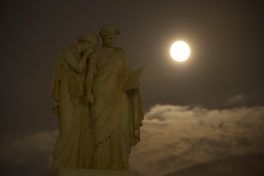
It has been long thought but never proved. The coincidence of the last super moon with a quake in New Zealand has again spurred a strong debate.
Dr John Ristau a Seismologist for GNS Science says it’s plausible that the moon could be a factor.
“When you get the tidal forces from the moon it does cause increased stresses in the Earth’s crust, so what can happen, potentially, is if you did have a fault that was almost at the very tipping point of rupturing, this could potentially act as the straw that broke the camel’s back.”
Looking at previous supermoons and possible connections to other major earthquakes, there was a supermoon on March 19 2011, eight days after the massive earthquake and tsunami that hit Japan.
On February 22 that year, Christchurch suffered a devastating quake in which 185 people died.
Like the previously unknown fault that ruptured under Christchurch in 2011, Dr Ristau adds:
“If you had a fault that was right there and was just about to break, all it needs is just one tiny little push. So that tiny little push, it could coincidentally happen at the time when there’s a full moon, when the tidal forces are high.”
When a deadly earthquake struck the South Island of New Zealand late last night, many people pointed to a post on Facebook that had supposedly predicted the event.
The post from Nigel Antony Gray on November 6 said:
“On November 14 and a couple of days either side of that date, watch for a major earthquake, and quite [possibly] in the South Pacific area.”
Mr Gray pointed to the increased gravitational pull of the “super moon” as the reason for his warning. November 14 marks the closest that the full moon has been to Earth this century.
But earthquake expert Mark Quigley from the University of Melbourne says Mr Gray’s prediction is not science.
Even if it’s true that tidal deformations of the Earth due to the movements of the Sun and Moon could trigger an earthquake in some circumstances.
“It is possible that, for active faults that are imminently close to brittle failure due to the accumulation of tectonic elastic strains over geological timescales, the comparably small perturbations from tidal forces could be enough to trigger an earthquake rupture, or to allow a propagating rupture to travel further than it might have in the absence of tidal stresses.”
In other words, if pressure has already been building up over for a long time, and an earthquake is imminent close, then, tidal stresses could be enough to trigger it.
Dr Quigley says “the plate tectonic setting of this earthquake, and the occurrence of several strong earthquakes in this region over the last few years, provide ample explanations for its occurrence”.
So can earthquakes be predicted? No. And the US Geological Survey says it’s likely that this will remain the case.
Scientists can know that an earthquake will take place in an area at some stage in the future. But they can’t know exactly when.
The mounting pressure of the Moon will decrease with the passing of time, albeit quite slowly! This was discovered by George Howard Darwin (Charles Darwin’s son) who had demonstrated, in a mathematical way, how the Moon’s orbit would evolve due to tidal friction.
The Moon’s orbit (its circular path around the Earth) is getting larger, at a rate of about 3.8 centimeters per year. The reason for the increase is that the Moon raises tides on the Earth. Because the side of the Earth that faces the Moon is closer, it feels a stronger pull of gravity than the center of the Earth. Similarly, the part of the Earth facing away from the Moon feels less gravity than the center of the Earth. This effect stretches the Earth a bit, making it a little bit oblong. We call the parts that stick out “tidal bulges.” The actual solid body of the Earth is distorted a few centimeters, but the most noticeable effect is the tides raised on the ocean.
Tidal friction, caused by the movement of the tidal bulge around the Earth, takes energy out of the Earth and puts it into the Moon’s orbit, making the Moon’s orbit larger.
The Earth’s rotation is slowing down because of this. One hundred years from now, the day will be 2 milliseconds longer than it is now.
It is not clear how the Moon was created, some think it was an asteroid captured by Earth’s gravity while other think that was a massive asteroid hitting the Earth 3.5 billion years ago which caused a chunk of our planet to be propelled into orbit.
